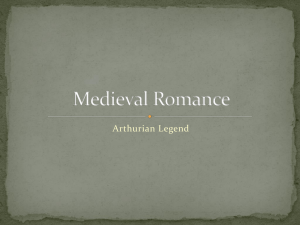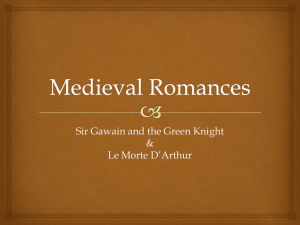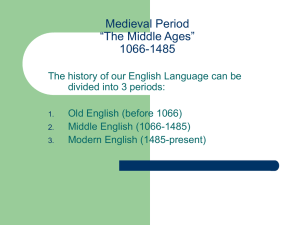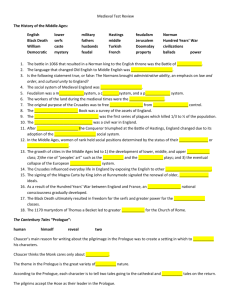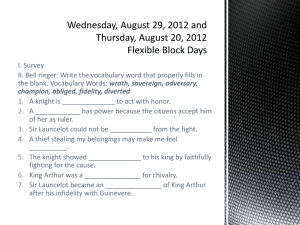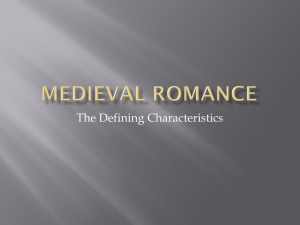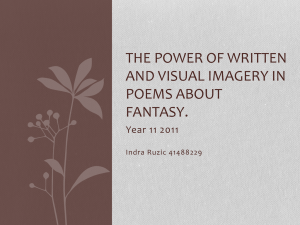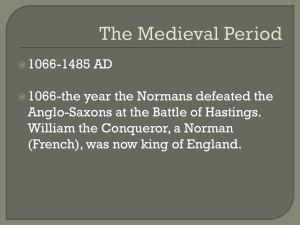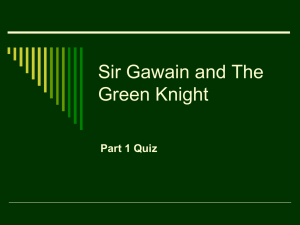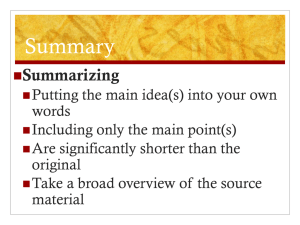NOTES - Medieval Literature - Part 2
advertisement
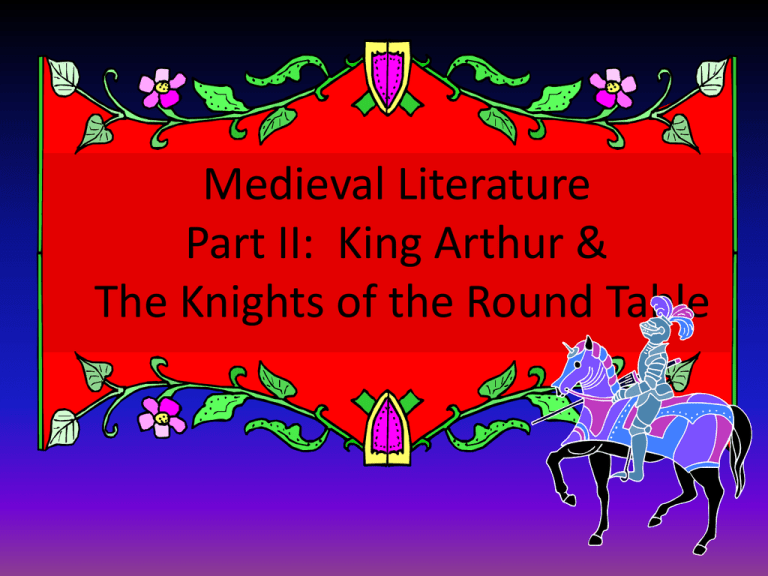
Medieval Literature Part II: King Arthur & The Knights of the Round Table Sir Gawain and the Green Knight • Author: The Gawain Poet / The Pearl Poet, most likely a contemporary of Geoffrey Chaucer. • Genre: Medieval Romance—contains noble heroes, gallant love, a chivalric code of honor, and daring deeds. Often include faraway settings, fantasy, and a lighthearted tone. • Source: Cotton Nero A.x. (Part of a collection of Medieval Literature owned by Robert Cotton.) • Importance: Emphasizes devotion to the code of chivalry, the test of honor, and the respect for courtly love, which required a knight to do whatever a damsel asked. Background: • Tales of King Arthur were especially popular during the Medieval Age due to the idealized world of Camelot, which greatly contrasted medieval reality. • This tale is one of the oldest Arthurian stories. • Stems from Welsh and English traditions, borrowing from earlier "beheading game" stories. • The "game" of exchanging gifts was common. If a man received a gift, he was obliged to provide the giver with a better gift or risk losing his honor, almost like an exchange of blows in a fight. The poem revolves around two games: an exchange of beheading and an exchange of winnings. Background (cont’d): Medieval symbolism • Green: Life, nature, immortality, safety, renewal, and hope. • Red: Blood, sacrifice, love, courage • Gold: Wealth, value, success • White: Goodness, virtue • Pentangle (Gawain’s five-pointed star on his shield): NOT a symbol of the occult as it is now. Was to remind man of things divine. Five different groups of five: the five wounds suffered by Christ on the cross, Gawain's five fingers, the five joys Mary found in the infant Christ, the five human senses, and a series of 5 virtues: Generosity, Love, Purity, Courtesy, & Compassion. Summary: A huge knight, dressed all in green, appears at Camelot on New Year’s Eve. The Green Knight challenges any man in the court to strike his bare neck with an axe, provided that the Green Knight may do the same to the man in a year and a day. Sir Gawain, the youngest of the knight’s and nephew to the king, accepts the challenge and severs the Green Knight’s head with one blow. The Green Knight retrieves his head and rides off, reminding Gawain to meet him at the Green Chapel on the proposed day. One year later, after many dangerous adventures and on his way to keep his appointment with the Green Knight, Gawain reaches a castle. Summary (cont’d): The lord and lady who reside there invite him to stay for a few days. The lady attempts to seduce Gawain, and even offers him several gifts, but he resists her advances. He keeps, however, her gift of a green sash which, she promises, “charms are woven within,” and he wraps it around his neck. After leaving the castle, Gawain faces the Green Knight. The Knight raises brings his axe down upon Gawain, thus fulfilling the pact; but Gawain’s neck is only nicked. The Green Knight explains that he himself had been Gawain’s host at the castle and had arranged for his wife to test Gawain’s honor. Le Morte d’Arthur (The Death of Arthur) • Author: Sir Thomas Malory • Genre: Arthurian Legend—Probably based on a REAL 5th or 6th cent. Celtic leader who defended Britain against the Anglo-Saxons. • Source(s): William Caxton’s 1485 first edition of Le Morte d’Arthur (a collection of Arthurian Tales) by Sir Thomas Malory; probably French collections of folklore. • Importance: King Arthur has come to represent the best of chivalry and of courtly behavior. The Arthurian legend describes a king who held to these principles in an attempt at perfection. Background: • The King Arthur Legend has existed for over 1,000 years. • FIRST developed in literature by Geoffrey of Monmouth, a Welsh monk, who wrote Historia Regum Britanniae (The History of the Kings of Britain) in about 1138. • Monmouth places the reign of King Arthur somewhere shortly after Britain's separation from the Roman Empire, around the year 410. • In 1155, an Anglo-Norman author, named Wace, wrote down his Roman de Brut in French, and introduced the Round Table into the Arthurian legend. • King Arthur legends continue to be a major influence of modern literature, movies, websites, and video games. Summary: King Arthur and his army have besieged Sir Launcelot in the fortified city of Benwick. Meanwhile, Sir Modred has seized Arthur’s throne and attempts to persuade Queen Gwynevere to marry him. Arthur sails back to Britain to regain his throne, and Gawain is injured as they fight their way ashore. Before dying, Gawain writes to Launcelot, begging him to help Arthur. In a vision, Gawain also warns Arthur that he will be killed if he battles Modred before Launcelot’s return. Summary (cont’d): Arthur makes peace with Modred, but fighting erupts at the signing of the treaty. Modred is killed, and Arthur is mortally wounded. Realizing that his end is near, Arthur commands Bedivere to throw Excalibur into a nearby lake. When Bedivere finally does as he is told, he later reports that he saw a hand rise from the water, catch the sword, shake it three times, brandish it, then pull it down. Arthur’s body is carried to that same waterside, and put aboard a mysterious barge. The barge takes the dead Arthur away to the land of Avalon, and no one sees him in Britain again. Sources: Lawrence, Mark. “The Importance of Gawain's Shield in Sir Gawain and the Green Knight.” Associated Content from Yahoo. (2007). <http://www.associatedcontent.com/article/467719/the_importance_of_ gawains_shield_in_pg2.html> “Sir Gawain and the Green Knight.” Wikipedia. <http: en.wikipedia.org/wiki/Sir_Gawain_and_the_Green_Knight> Taylor, Patrick. “Arthurian legend - a summary of Le Morte d'Arthur.” (2011.) <http://www.arthurian-legend.com/>
